T5AI-Board Development Board
Last Updated on : 2025-07-07 08:17:40download
Tuya T5AI-Board is a voice and screen multi-interaction development board based on the T5-E1-IPEX, an embedded Wi-Fi and Bluetooth combo module developed by Tuya Smart. Equipped with two microphones and one speaker, the development board supports voice recognition and playback, offering voice interaction capabilities.
Through the I/O connector on the development board, you can use an LCD display sub-board to implement the touch screen and camera capture features. You can also design your own LCD screen with various interfaces, including I2C, SPI, 8080, and RGB interfaces. This way, implement human-machine interaction and meet the users’ development requirements for products used in various scenarios.
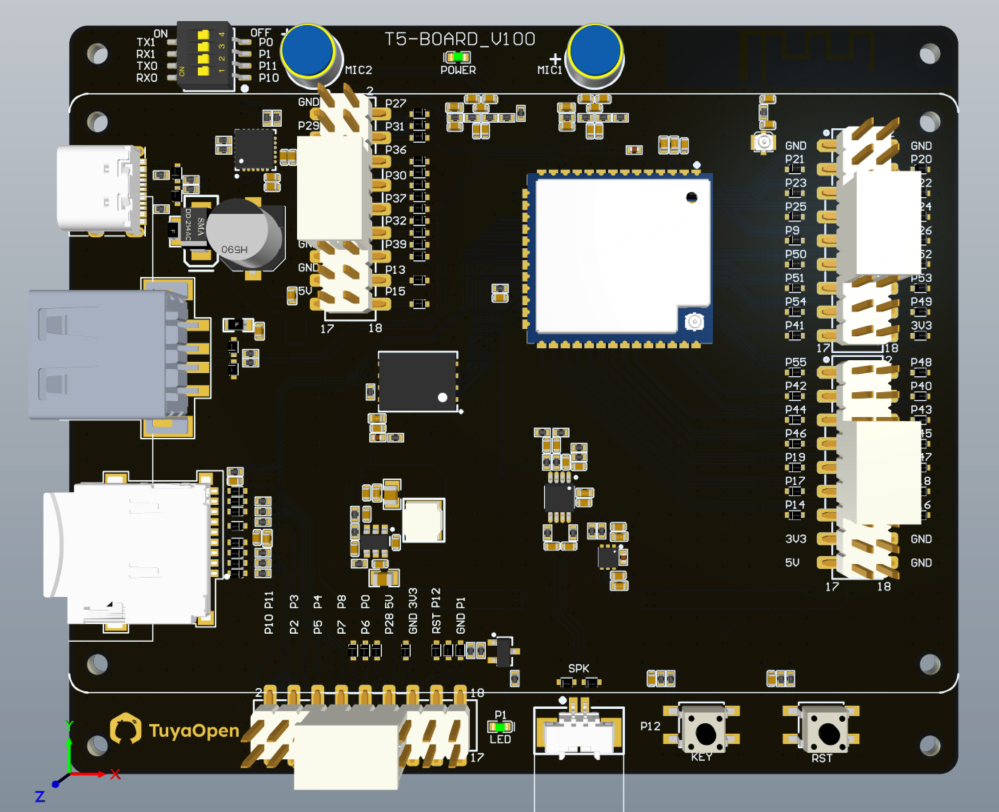
The following LCD display sub-boards are supported:
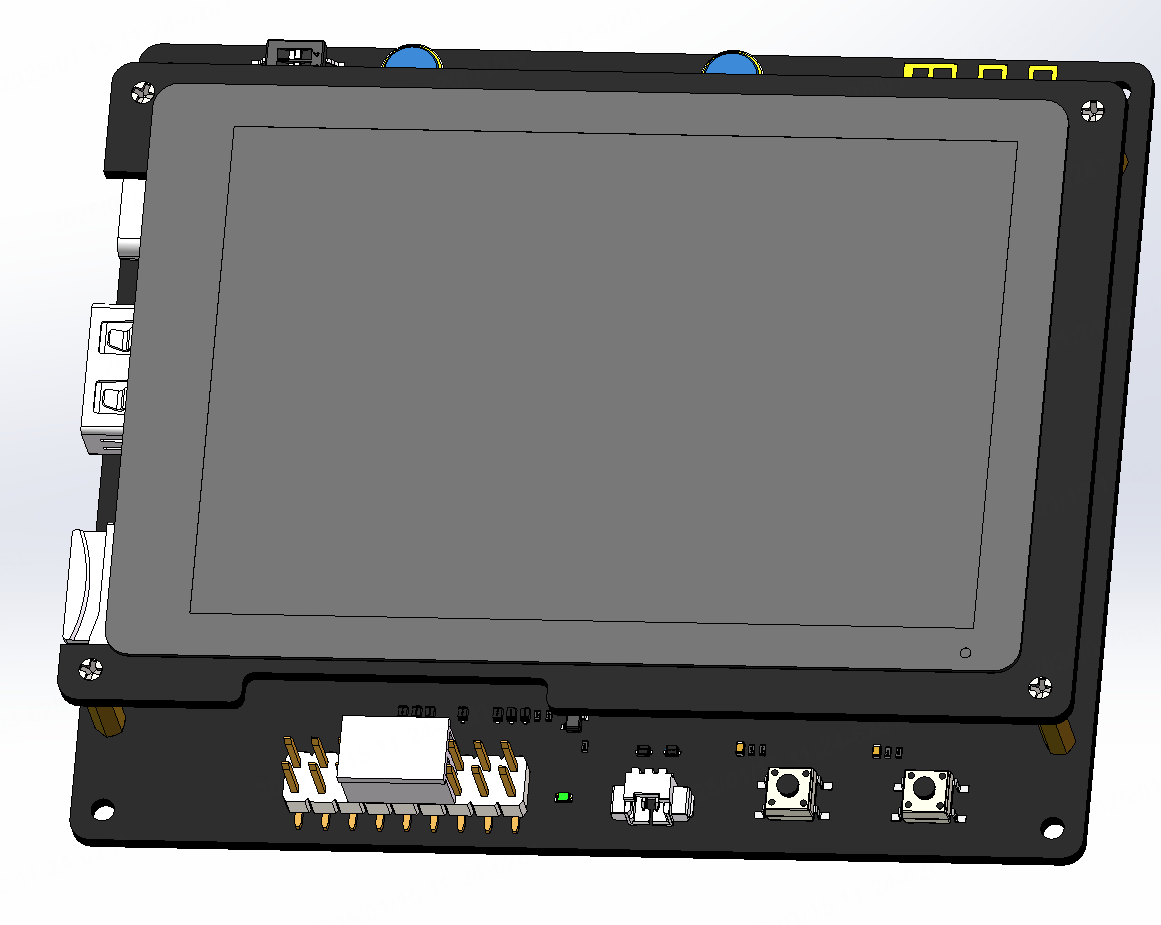
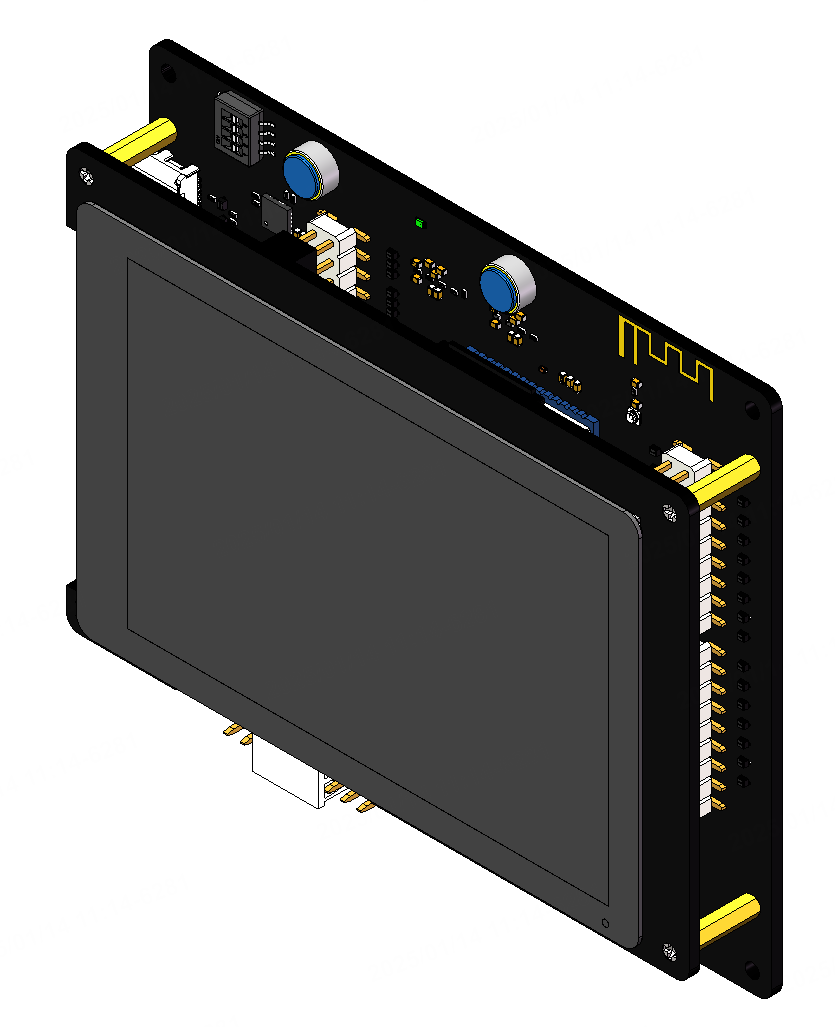
The following binocular LCD display sub-boards are supported:
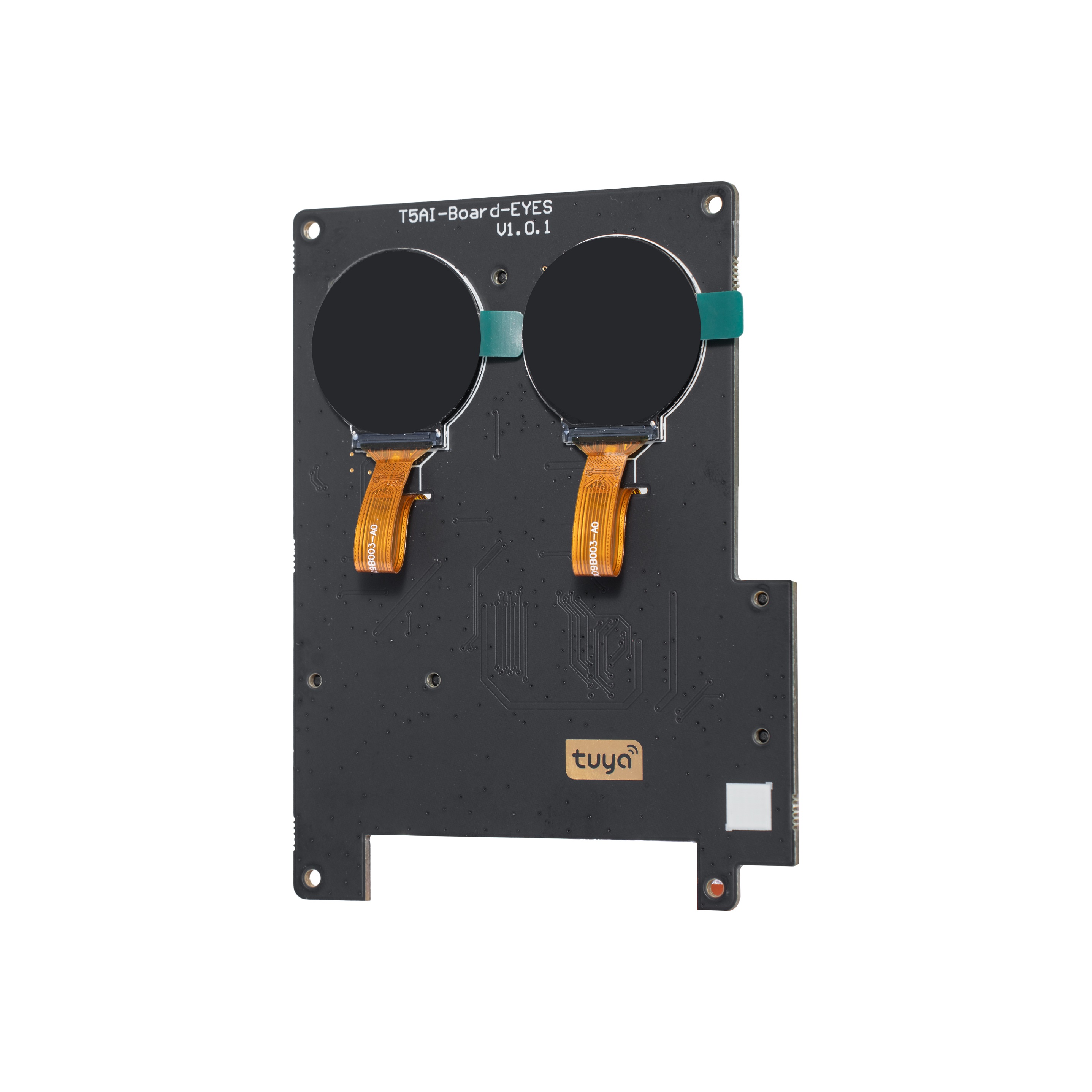
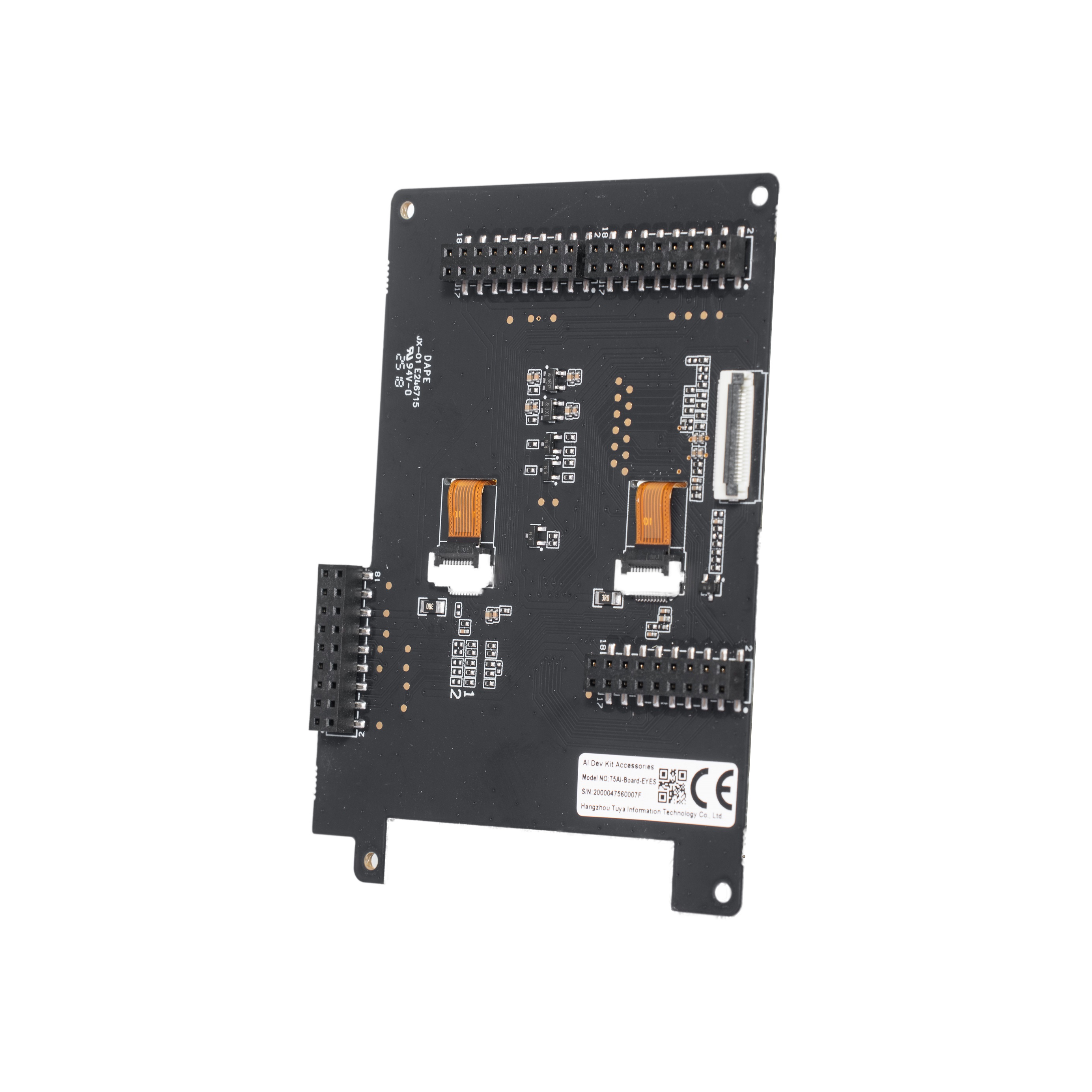
Features
- Module: T5-E1-IPEX
- ARMv8-M Star (M33F) @480MHz
- 16KB ITCM and 16KB DTCM
- 8 MB SiP flash memory
- 16 MB SiP PSRAM
- 640 KB shared SRAM
- Audio: 2-channel 16-bit audio ADC, 1-channel 16-bit audio DAC, and a 4-band digital equalizer.
- Screen: Can be matched with different screen displays, supporting screens with I2C, SPI, RGB, and 8080 interfaces.
- Camera: Camera module with DVP and USB interfaces.
- USB: USB 2.0 on USB type-A interface and USB type-C interface for download and debugging.
- TF card: Expand the storage capacity.
- I/O connectors: 56x GPIOs, configurable peripherals, 2x SPI, 2x QSPI, 3x UART, 2x I2C, 1x SDIO, 1x CAN, 12x PWM, and 3x I2S.
- Wi-Fi
- IEEE 802.11b/g/n/ax compliant
- 20 MHz and 40 MHz channel bandwidth
- Support downlink multi-user multiple input, multiple output (DL MU-MIMO)
- Integrated Bluetooth and Wi-Fi coexistence (packet traffic arbitration, PTA)
- Support target wake time (TWT)
- Bluetooth
- Support Bluetooth LE 5.4 standard
- TX power of +6 dBm
- RX sensitivity of -97 dBm
Obtaining method
Please go to Product details page on the Taobao website to purchase.
Functional block diagram
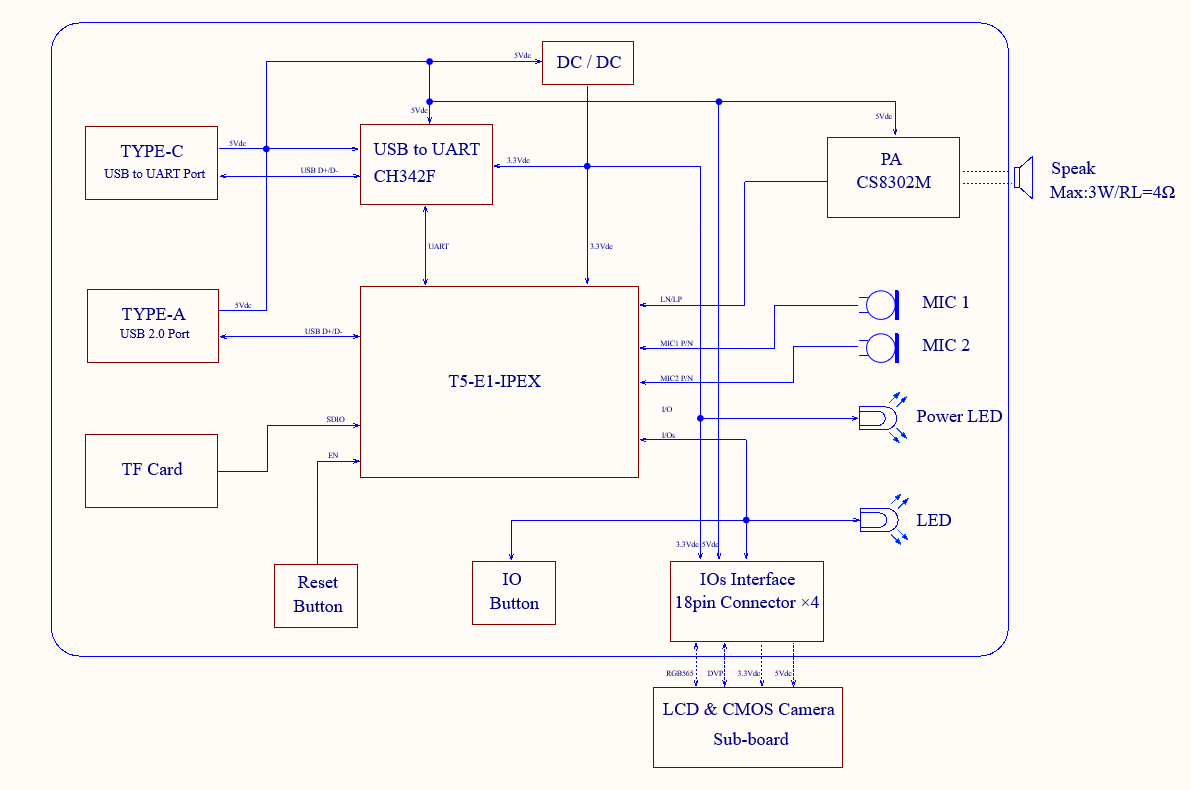
Peripherals
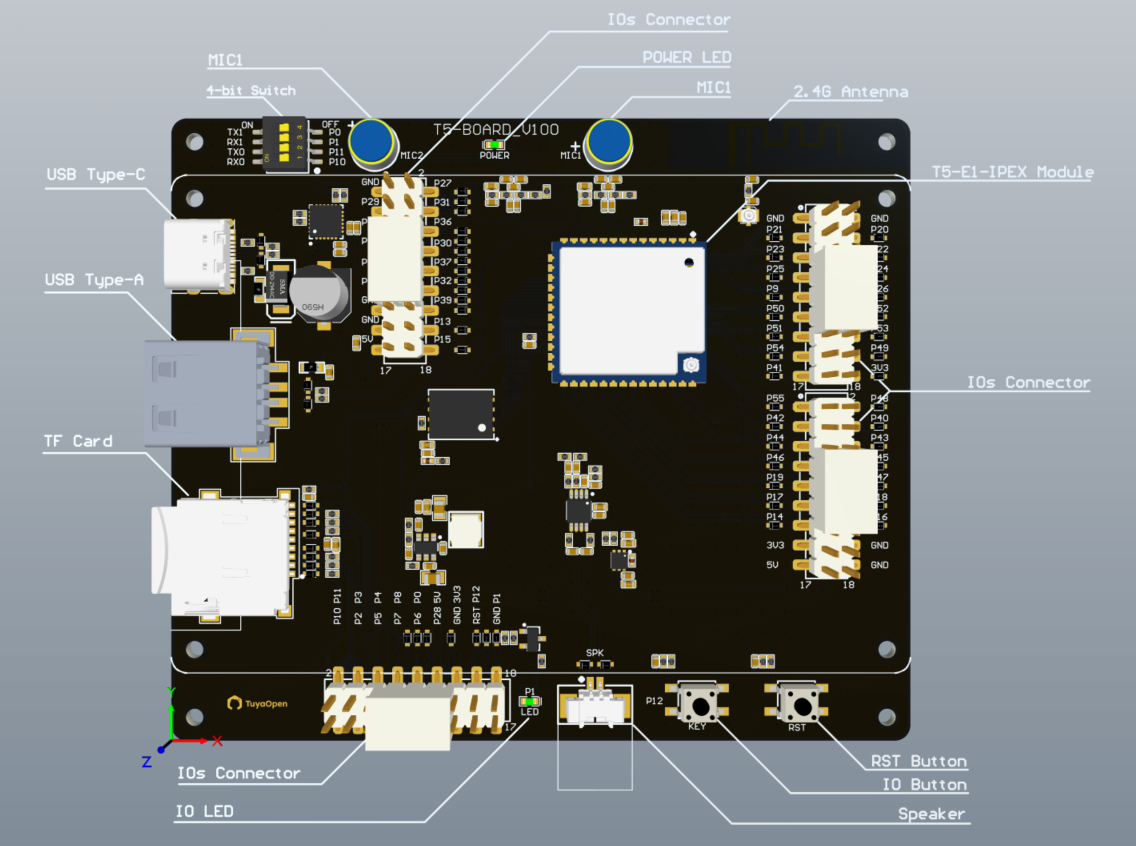
| Peripheral | Description |
|---|---|
| T5-E1-IPEX module | An embedded Wi-Fi and Bluetooth combo module used to control the development board. With rich peripheral interfaces and powerful signal processing capabilities, this module is suitable for various scenarios in the AIOT field. |
| I/O connector | This connector features a 2.54 mm pitch and 56 GPIOs, configurable for driving a touchscreen, camera module, segment display, and more. For more information about the pins, refer to the I/O connector description section. |
| RST button | The enable (EN) pin of the T5-E1-IPEX module is used to reset the module. |
| I/O button | Connected to P12 of the T5-E1-IPEX module, it can be configured as a button. |
| Speaker | The speaker connector has a 1.25 mm pitch and can drive speakers up to 3W/RL=4Ω. |
| I/O LED | Connected to P01 of the T5-E1-IPEX module, it can be configured as an LED indicator. |
| TF card | The TF card connector can be used to expand the memory capacity of the T5-E1-IPEX module. |
| USB type-A | High-speed USB 2.0 interface supports cameras with USB interfaces. |
| USB type-C | The power port includes an onboard USB-to-serial chip, providing two virtual serial ports for module flashing and debugging. |
| 4-bit switch | The DIP switch is used to open and close the circuit between two serial ports on the USB-to-serial chip. |
| MIC1 and MIC2 | The audio input port, along with the onboard microphone, is connected to the module’s dual-channel audio ADC. |
| Power LED | Power indicator of the development board. |
| 2.4 GHz antenna | 2.4 GHz Wi-Fi onboard antenna |
I/O connector description
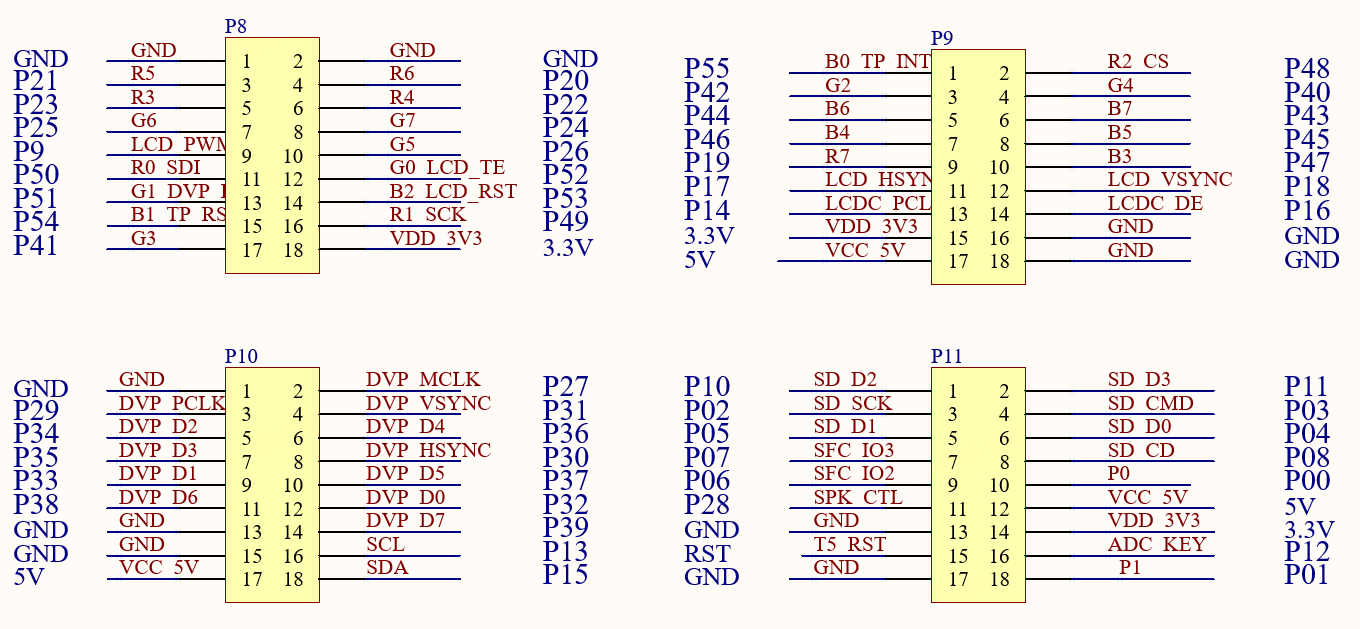
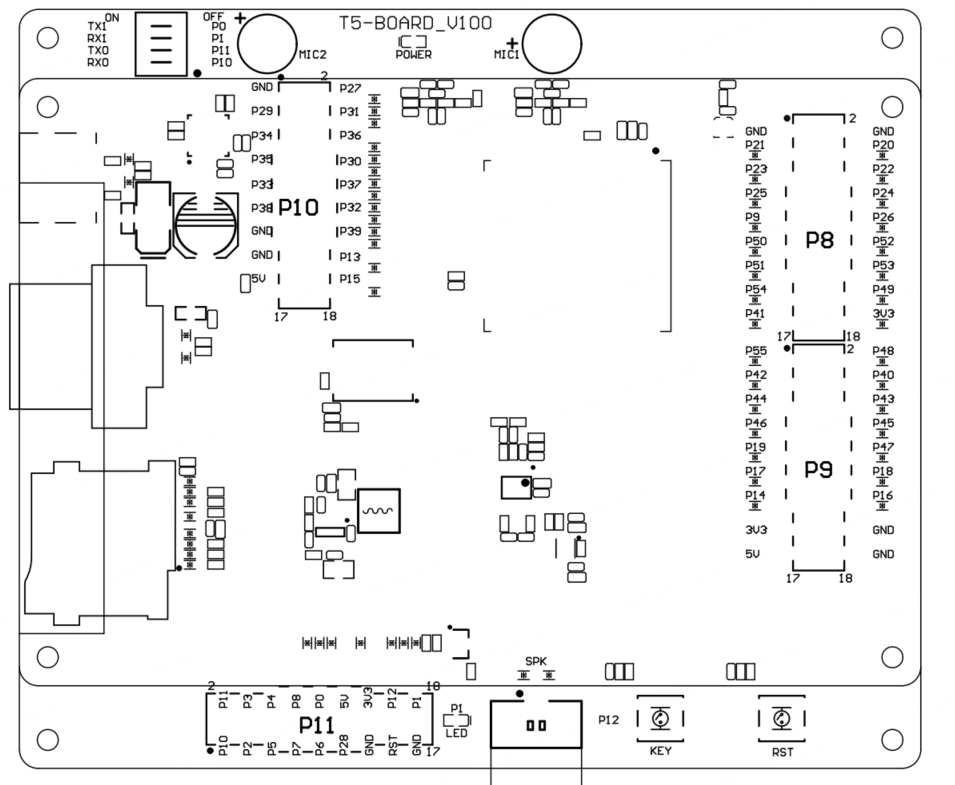
For more information about I/O features, refer to the pin definition in the T5-E1-IPEX module datasheet.
Recommended I/O configuration of RGB565 LCD, camera module, and TF card
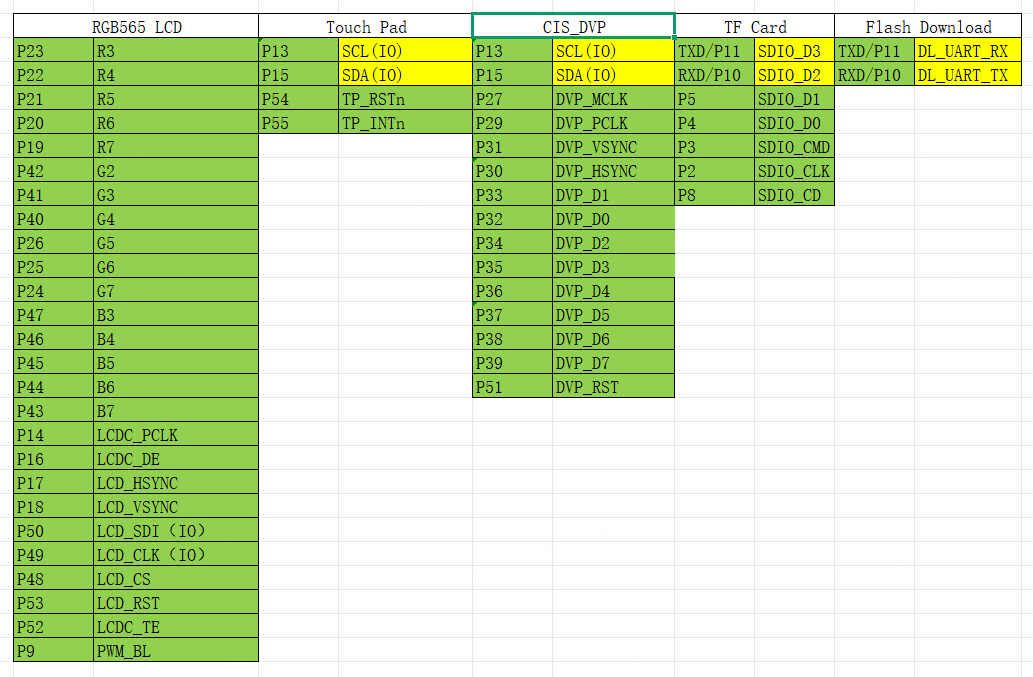
- The camera and touch pad share an I2C interface.
- The DATA3 and DATA2 pins of the TF card are multiplexed with the module’s UART port for flashing.
Recommended I/O configuration of SPI LCD
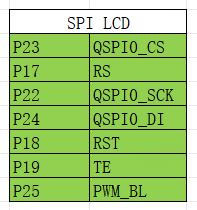
Radio frequency (RF) parameters
Basic RF features
| Parameter | Description |
|---|---|
| Operating frequency | 2.412 to 2.484 GHz |
| Wi-Fi standard | IEEE 802.11b/g/n/ax (channels 1–14) |
| Data transmission rate |
|
| Antenna type | PCB onboard antenna |
Wi-Fi transmitter (TX) performance
| Parameter | Min value | Typical value | Max value | Unit |
|---|---|---|---|---|
| RF average output power, 802.11b CCK mode, 11 Mbit/s | 15 | 17 | 19 | dBm |
| RF average output power, 802.11g OFDM mode, 54 Mbit/s | 13 | 15 | 17 | dBm |
| RF average output power, 802.11n OFDM mode, HT20 MCS7 | 12 | 14 | 16 | dBm |
| RF average output power, 802.11n OFDM mode, HT40 MCS7 | 11 | 13 | 15 | dBm |
| RF average output power, 802.11ax OFDMA mode, HE20 MCS7 | 12 | 14 | 16 | dBm |
| RF average output power, 802.11ax OFDMA mode, HE40 MCS7 | 11 | 13 | 15 | dBm |
| Frequency error | -20 | - | 20 | ppm |
Wi-Fi receiver (RX) performance
| Parameter | Min value | Typical value | Max value | Unit |
|---|---|---|---|---|
| PER < 8%, RX sensitivity, 802.11b DSSS mode, 11 Mbit/s | - | -88 | - | dBm |
| PER < 10%, RX sensitivity, 802.11g OFDM mode, 54 Mbit/s | - | -74 | - | dBm |
| PER < 10%, RX sensitivity, 802.11n OFDM mode, HT40 MCS7 | - | -73 | - | dBm |
| PER < 10%, RX sensitivity, 802.11ax OFDMA mode, HE40 MCS7 | - | -73 | - | dBm |
| PER < 10%, RX sensitivity, Bluetooth LE, 1 Mbit/s | - | -97 | - | dBm |
Bluetooth TX performance
| Parameter | Min value | Typical value | Max value | Unit |
|---|---|---|---|---|
| Operating frequency | 2402 | - | 2480 | MHz |
| Transmission rate over the air | - | - | - | Mbit/s |
| Transmission power | -20 | 6 | 15 | dBm |
| Frequency error | -150 | - | 150 | MHz |
Bluetooth RX performance
| Parameter | Min value | Typical value | Max value | Unit |
|---|---|---|---|---|
| RX sensitivity | - | -97 | - | dBm |
| Max RF signal input | -10 | - | - | dBm |
| Intermodulation | - | - | -23 | dBm |
| Co-channel rejection ratio | - | 10 | - | dB |
Reference
LCD sub-board screen
| Display type | Color number | Number of dots | Driver IC | TP IC |
|---|---|---|---|---|
| 3.5" TFT | 16.7M | 320(RGB) × 480 dots | ILI9488 | GT1151QM |
| 0.9" IPS | 16.7M | 128 × 128 | ST7735 | - |
LCD sub-board camera
| Sensor type | Array size | Resolution | Sensor IC | I2C Addr |
|---|---|---|---|---|
| OVX4388 | 1600 × 1200 | 800 × 600 | GC2145 | 0x78, 0x79 |
Explore more
- Schematic diagram of the development board
- Pinout of the development board
- I/O connector location
- Schematic diagram of LCD sub-board
- Schematic diagram of LCD dual-lens sub-board
USB-to-serial chip driver
Download the USB-to-serial chip driver for your operating system.
Appendix: Statement
FCC Caution:Any changes or modifications not expressly approved by the party responsible for compliance could void the user’s authority to operate this device.This device complies with Part 15 of the FCC Rules. Operation is subject to the following two conditions: (1) This device may not cause harmful interference, and (2) this device must accept any interference received, including interference that may cause undesired operation.
List of applicable FCC rules
This module has been granted modular approval as below listed FCC rule parts. -FCC Rule parts 15C (15.247)
List of applicable ISED rules
This module has been certificated modular approval as below listed ISED Radio Standards Specifications.
- RSS 247 Issue 3
This device generates, uses, and can radiate radio frequency energy and, if not
installed and used following the instructions, may cause harmful interference to
radio communications. However, there is no guarantee that interference will not
occur in a particular installation. If this device does cause harmful interference to
radio or television reception, which can be determined by turning the device off
and on, the user is encouraged to try to correct the interference by one or more
of the following measures: - Reorient or relocate the receiving antenna.
- Increase the separation between the device and receiver.
- Connect the device to an outlet on a circuit different from that to which the receiver is connected.
- Consult the dealer or an experienced radio/TV technician for help.
Radiation Exposure Statement
This device complies with FCC radiation exposure limits set forth for an uncontrolled rolled environment. This device should be installed and operated with a minimum distance of 20cm between the radiator and your body.
Important Note
This radio module must not be installed to co-locate and operate simultaneously with other radios in the host system except by following FCC multi-transmitter product procedures. Additional testing and device authorization may be required to operate simultaneously with other radios.
The availability of some specific channels and/or operational frequency bands are country dependent and are firmware programmed at the factory to match the intended destination. The firmware setting is not accessible to the end-user.
Declaration of Conformity European Notice

Hereby, Hangzhou Tuya Information Technology Co., Ltd declares that this module product is in compliance with essential requirements and other relevant provisions of Directive 2014/53/EU,2011/65/EU. A copy of the Declaration of Conformity can be found at https://www.tuya.com.

This product must not be disposed of as normal household waste, in accordance with the EU directive for waste electrical and electronic equipment (WEEE-2012/19/EU). Instead, it should be disposed of by returning it to the point of sale or to a municipal recycling collection point.
The device could be used with a separation distance of 20cm from the human body.
Industry Canada Statement
This device complies with Industry Canada’s licence-exempt RSSs. Operation is subject to the following two conditions:
(1) This device may not cause interference.
(2) This device must accept any interference, including interference that may cause undesired operation of the device.
Le présent appareil est conforme aux CNR d’Industrie Canada applicables aux appareils radio exempts de licence. L’exploitation est autorisée aux deux conditions suivantes:
(1) l’appareil ne doit pas produire de brouillage.
(2) l’utilisateur de l’appareil doit accepter tout brouillage radioélectrique sub i, même si le brouillage est susceptible d’en compromettre le fonctionnement.
Radiation Exposure Statement
This equipment complies with IC radiation exposure limits set forth for an uncontrolled environment. This equipment should be installed and operated with minimum distance 20 cm between the radiator & your body.
Déclaration d’exposition aux radiations:
Cet équipement est conforme aux limites d’exposition aux rayonnements ISED établies pour un environnement non contrôlé. Cet équipement doit être installé et utilisé avec un minimum de 20 cm de distance entre la source de rayonnement et votre corps.
L’appareil peut interrompre automatiquement la transmission en cas d’absence d’informations à transmettre ou de panne opé rationnelle. Notez que ceci n’est pas destiné à interdire la transmission d’informations de contrôle ou de signalisation ou l’utilisation de codes répétitifs lorsque cela est requis par la technologie.
Is this page helpful?
YesFeedbackIs this page helpful?
YesFeedback





